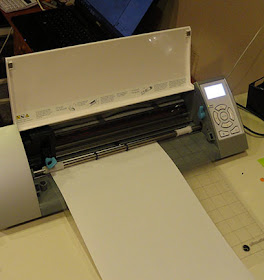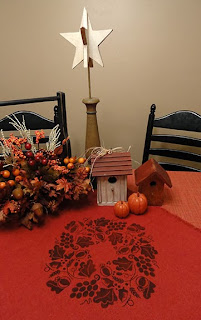Here is a tutorial for a stenciled Thanksgiving table topper
using this new wreath design
available from SnapDragon Snippets
through the Silhouette America online store.
The original design size is just under 12"x12", but it is also presented as a quarter "repeatable" design portion for making a larger wreath in sections.
The tutorial will focus on creating an enlarged wreath that is
larger than the cutting mat can contain.
Registration markings allow the quarter section to be
cut separately, then carefully placed one by one around a quarter-marked
fabric center and stencil painted.
cut separately, then carefully placed one by one around a quarter-marked
fabric center and stencil painted.
1. Download the file, ungroup so that the quarter section
can be manipulated by itself, then scaled (size enlarged or reduced).
This screen shot shows the original quarter section on the right,
and the enlarged (or scaled) section on the cutting mat.
By comparing the whole wreath size (approx. 11.9" wide)
to the size I want to make (14" wide), I can run the formula to determine
the enlargement percentage.
(Formula: target size 14" divided by beginning size 11.9" = 117% approx.)
This 117% is entered into the scaling tool percentage box
(visible in the right hand panel above).
 2. Arrange the adjusted cut file on your Studio screen for best use of vinyl product you are using. Change cut setting for vinyl, and send the job to cut. (You will need to cut four for the complete wreath.) I like to use a cutting mat when I cut vinyl, and I have left my vinyl roll uncut. I will trim efficiently once the design has been cut.
2. Arrange the adjusted cut file on your Studio screen for best use of vinyl product you are using. Change cut setting for vinyl, and send the job to cut. (You will need to cut four for the complete wreath.) I like to use a cutting mat when I cut vinyl, and I have left my vinyl roll uncut. I will trim efficiently once the design has been cut.
3. This tutorial uses clear stencil vinyl from Silhouette America's online store (or Archivers also carries this product in some stores). It unfortunately is fairly expensive, and only 9 inches wide. Clear transfer tape is included in the same package. For my 14" wreath with 4 nine inch repeats to cut, I will use the entire 36" length.
4. Weed the cut stencil design from the "background". This is "backwards" from the process of preparing regular vinyl, so it may require some steady and concentrated thinking to leave the parts that MASK OFF the surface where the paint in the project SHOULD NOT BE APPLIED.
5. Locate the cross lines and single line registration marks on the cut vinyl. Use an ink pen (ball point may smear less than a felt liner) to mark the cuts for better visibility when aligning on the media later in the process.
(I am using a straight edge in the image, but this is not really necessary.)
6. Remove paper backing from the clear transfer sheet and smooth transfer sheet into place over the weeded stencil vinyl design. I like to release a little of the transfer sheet along one edge, apply it to the side of the design vinyl, then continue to apply and release across until it is all in place. It is easier to handle and avoid having one "grabby" sticky sheet.
7. Use a scraper tool to burnish across the whole design. This will help the vinyl adhere to the transfer sheet.
8. Remove the vinyl from its paper carrier by carefully rolling off the transfer sheet. Because this is a delicate design, watch to make sure all the separate shapes (leaf vein, pod top scallop shape and crescents, acorn sawtooth inner shape, etc.) transfer in correct position.
9. Find the center of the surface to which the stencil will be applied. To do this with my linen fabric square, I fold in half and then into quarters and crease the corner through all folds by finger pressing.
Here you can see the center cross hair creases that mark my center.
10. Place a temporary piece of tape at center and ink a cross exactly over the folds for better visibility.
Use a gridded ruler tool to extend the cross hair markings to approx. 8" beyond center on each of the four "directions". I have placed another piece of masking tape to hold my marks temporarily.
11. Locate the center cut/inked mark on the vinyl. For this project and vinyl section, the mark can be seen near my thumb.
Position the vinyl center mark exactly over the tape/penned center mark, and at the same time align the side registration line on the extended tape/penned line mark.
Apply pressure over all the stencil, and burnish well with a scraper tool or credit card edge. Peel back the transfer sheet to reveal the stencil, taking special care at all the tiny individual pieces and delicate edges to make sure they transfer, and do not tear.
12. Use masking tape to tape across the edges of the stencil to protect the non-covered portion of the media (fabric in this project) from stencil paint. Apply more tape rows if a larger margin is desirable for adequate protection.
13. Apply your stencil medium. I am using acrylic stencil paste by Delta, with a stencil brush.
Use conventional stenciling brush technique (brush toward the center of an open design area to avoid scraping paint under the stencil surface). In the image you can see how the paint is coloring the fabric, but is masked from the vinyl-covered areas. This step is a bit like magic! So fun to see the design "re-appear"!
14. When the first section is dry, remove the stencil and protective tape at edges. You will need to use a tool like the weeder, or tweezers, etc., to remove the small separate pieces like the leaf vein seen still in place here.
Repeat the prep and placement process for stencil section 2, paint, let dry, remove stencil. Then repeat for sections 3 and 4, one at a time.
Of course, the easier way to complete the stencil is by cutting the whole design as one unit. In that version, you would need a larger size Silhouette cutting mat, and also a stencil medium that is that wide. Though I have no experience to back the notion up, I believe regular stencil vinyl would also work for the process. It is NOT clear, but is wider.
 Hope this process presentation provides some fuel for your imagination. What other stenciling designs would you like to see in the Silhouette online store? Either request a design through the online store, or email me with your request or idea, and we will see what can be done. hearthsewnpatterns(at)yahoo(dot)com
Hope this process presentation provides some fuel for your imagination. What other stenciling designs would you like to see in the Silhouette online store? Either request a design through the online store, or email me with your request or idea, and we will see what can be done. hearthsewnpatterns(at)yahoo(dot)com






















































